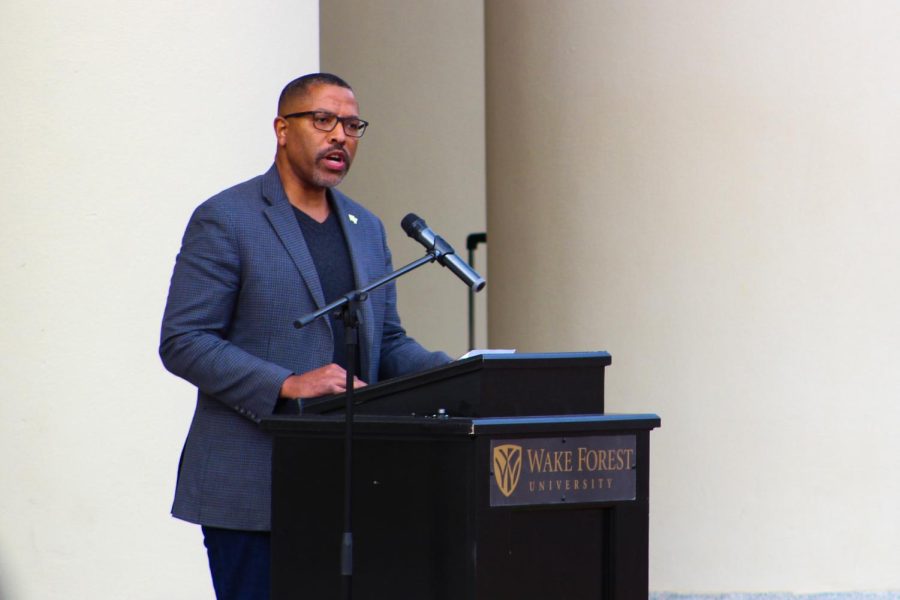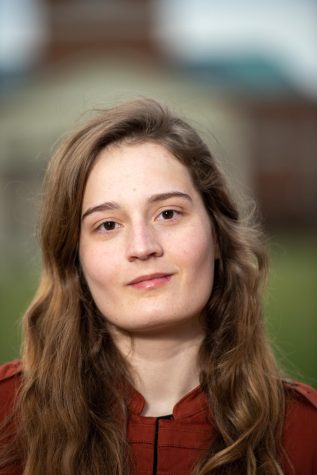University hosts fifth annual Commemoration of the Enslaved
The campus community gathered to honor the enslaved individuals whose labor benefitted Wake Forest
Dr. Corey D.B. Walker speaks at the Commemoration of the Enslaved.
May 2, 2023
Wake Forest faculty, staff, students, alumni and community members gathered outside of Wait Chapel for the fifth annual Commemoration of the Enslaved on April 25. The event, which began in 2019, was created to honor the enslaved people who were either sold for or labored for the benefit of Wake Forest University.
Vice President for Diversity and Inclusion Dr. José Villalba began the program, which for the first time was planned and sponsored by the Office of Diversity and Inclusion rather than the Slavery, Race and Memory Project at the request of Provost Dr. Michele Gillespie. In addition to thanking everyone for attending, he explained Wake Forest’s historical engagement with the institution of slavery.
“Today marks the fifth time in Wake Forest history that we have commemorated the 16 enslaved individuals — the 16 souls — that were sold as part of the Blount estate in 1860 to support the Wake Forest endowment,” Villalba said, adding that dozens more enslaved people had been linked to the founding of the school.
Following Villalba’s introduction, Gillespie addressed the crowd.
“Today we come together to remember and honor men, women and children whose names we know and whose lives and work shaped Wake Forest,” Gillespie said. “We recognize our responsibility to name them and to honor the names we do not know whose lives and work shaped Wake Forest profoundly, too.”
She discussed how Wake Forest University was originally founded on a former plantation and acknowledged the work enslaved individuals did to provide for white students, which among other tasks included tending to farm animals, crops, cleaning and construction.

“We hold ourselves accountable for changing a narrative largely marked by omission,” Gillespie continued, going on to introduce Interim Dean of Wake Forest University School of Divinity, Director of the Program for African American Studies, and Wake Forest Professor of the Humanities Dr. Corey D. B. Walker.
Walker opened by reading “The Mothering Blackness,” a poem written by the late civil rights activist and poet, Dr. Maya Angelou, who taught at Wake Forest from 1982 to 2011.
“[This poem] captures the gift of blackness,” Walker said. Not of blackness that is a threat. Not of blackness that is a problem, not of blackness as deviant and not of blackness as deficient.”
He continued: “Here, blackness operates as the safe space of authenticity and affirmation. It is a blackness that is wholeness and healing, welcoming one home. In a moment where our community gathers in a moment of remembrance and reflection, we remember the gift of blackness… This gathering is not mere repetition nor a rehearsal of what has gone on before. It is the founding of a new Wake Forest… This is why we gather this afternoon — to receive this gift and enact a new world.”
Associate professor of religion and culture Dr. Derick Hicks followed Walker, who made additional remarks stressing the humanity of those that were enslaved by or who labored for Wake Forest.
“[These people] were enfleshed,” Hicks said. “They weren’t a long time ago. They still live within the confines of this place and where we previously were on our original campus.”
He proceeded to explain the proceedings of the commemoration — speakers would read out the names of these enslaved people, and attendees would repeat the words “We remember and honor you.”
Hicks then described the first recorded instance of Wake Forest employing enslaved labor. In 1834, Wake Forest’s account books show that four enslaved Black people (three of which were named in the book) were rented, which was a common Southern practice in the period. Their names were Ellick, Harry and his wife, and Charlotte.
Hicks went on to state that the number of slaves rented from slave owners grew as the student population grew. In the following years, 13 more enslaved black people were rented in 1835: Johnson, Anderson, James, Lender, Mary, Sarah, Phillis, Mary, Lucey, Venus, Patience, Mary and George. In 1836, 16 enslaved black people were rented from owners. There were two families of four: one was Ted, Amy Jones and their two children. Another was Aggy, Maranda and Aggy’s children. The remaining eight were named Murphy, Rose, Martha, Lexy, Mary Sherwood, Mary Harris, David and Anderson.
Student Body President Pilar Agudelo also described two enslaved people who were killed in a fall during the 1835 construction of a college building and an enslaved person who labored as a custodian, all of whose names remain unknown.
In the 1840s, two enslaved people — Betty and Inez — were sold, and the proceeds of the sale were given to Wake Forest.
The next names were read by Christian Burris, a graduate of Wake Forest and Serials Acquisitions Coordinator in the ZSR Library. He gave additional information about the Blount estate, which was bequeathed to the university by plantation owner John Blount in 1836 and included land, homes and enslaved individuals. His wife Rebecca Blount remained in possession of the property until her death in 1859, and in 1860, the enslaved people were sold — the funds started the college’s first endowment.
Their names were Harvey, Tom, Venus and her child, Mary, Emma, Lettice, Isaac, Jim, Lucy, Caroline, Pompie, Emma, Nancy, Harriet and her child, Joseph, Harry, Ann and her two children, Thomas and Mary.
After the last series of names was read — just as they had each time before — the audience collectively repeated the phrase, “We remember and honor you.”
Senior Elizabeth MacDonald, who attended the event to gain a greater understanding of the school’s history before her graduation, spoke about how far Wake Forest has come and how far it still has to go.
“I feel like Wake Forest does a good job of acknowledging briefly various areas of its more unsavory, shameful, dark past,” MacDonald said. “I also think that from conversations I’ve had with leading administrators throughout my time at Wake Forest, these issues are on the minds of people who are making strategic decisions about the university, and they also realize that more can be done all the time…”
MacDonald continued: “But I think that there’s still a long way to go for everyone to be satisfied on this subject matter.”















